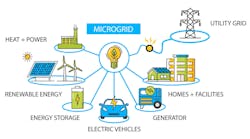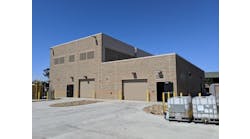Renewable natural gas, or RNG, is emerging as a new frontier for microgrids and a way to resolve one of the industry’s core dilemmas. How can it assure the lights stay on without relying on fossil fuels?
Business models are just beginning to emerge for renewable fuel microgrids. And Texas-based Enchanted Rock is one of the companies early out of the gate.
In a recent interview, Enchanted Rock offered us a look inside its strategy for renewable natural gas, a fuel made from capturing methane produced by decomposing waste from livestock, water treatment, food and other sources.
To start, it’s important to understand Enchanted Rock’s approach to microgrids. The company is best known for its fossil fuel-fired microgrids installed at retail stores in Texas, such as Buc-ee’s, H.E.B. and Walmart — stores that make the national news during disasters because their microgrids allow them to stay open and supply the local population.
During such outages, the generators provide power to the stores. But Enchanted Rock’s microgrids are about a lot more than warding off the darkness. When the electrical system is operating as it should, Enchanted Rock’s fleet is cued to the grid. It leverages that relationship to provide services to the grid and earn revenue. One way to think about it — the grid buys the microgrid’s electricity during blue sky days and the customer buys it during power outages, said Allan Schurr, chief commercial officer at Enchanted Rock.
Customers’ choices
Enchanted Rock’s renewable natural gas product is voluntary — customers can forego it and continue to use fossil fuels. Those who opt to switch can choose from two products. One is for “resiliency only,” Schurr said, meaning renewable gas is used only when the microgrid is islanded, such as during a power outage. The second option provides renewable gas for a lengthier period. The customer also uses it when the microgrid is operating in conjunction with the grid.
Given that renewable natural gas is generally more expensive than natural gas, the customer who opts for its extended use could see a rise in energy costs, while the resiliency only customer may see no change. As Enchanted Rock sees it, customers intent on meeting sustainability goals are likely to be more tolerant of paying extra. Exactly how much extra the fuel will cost depends on a range of factors, including the source of the renewable natural gas.
Building the renewable natural gas market
Enchanted Rock created its renewable natural gas product with the future in mind. The company wants to help make renewable natural gas more available. To that end, Enchanted Rock requires that the customer sign at least a 10-year agreement “so that it results in net new project development, where possible,” Schurr said. “A short-term commitment — all we’re doing is buying what’s already being produced. If we can make a long-term commitment, we’ll be able to impact new methane capture, new project development.”
Schurr believes Enchanted Rock will send a strong demand signal to renewable natural gas developers.
“We think that we’re going to be a very strong market participant, and I think we’re going to find costs are more affordable over time because of that,” he said
He explained that RNG is used today mostly for transportation. But the sector is wary of signing long-term off take agreements for renewable natural gas because cars and trucks are moving away from combustion engines and toward electrification.
“They don’t want to commit to a long-term contract, only to find out that they’ve now converted all of their delivery vehicles to electric. We’re not that way. We are a long-term off taker,” he said.
Mirrors solar market
To be clear, the microgrid customers don’t actually receive the renewable natural gas at their site. Instead it is pumped into gas lines where it mixes with natural gas and displaces some of the fossil fuel.
In that respect, the renewable natural gas model mirrors a common approach used in the solar market, where companies and institutions purchase renewable energy certificates, rather than the actual commodity. The customer commits to pay for solar energy produced at a facility that it is not physically connected to — the solar facility may actually be in another state. The customer’s payment results in solar-produced electrons being injected onto the grid, displacing fossil-fuel produced electrons. The customer receives certificates or credits for doing this and can apply the certificates toward meeting its sustainability or renewable energy goals.
“A methane molecule is literally a methane molecule. They’re indistinguishable, much like an electron is an electron. It’s commonly accepted that gas produced and injected in the pipeline is offsetting the use of fossil methane. Therefore, the credits can be tracked,” Schurr said.
Again, similar to the approach used for solar, the molecule is tracked at its point of injection accompanied by its clean energy attributes. The attributes are then decoupled from the point of injection and reattached at the point of extraction in the form of a credit given to the customer.
Begins with ESG planning
Allan Schurr, chief commercial officer at Enchanted Rock
Not all renewable natural gas is created equal from a sustainability perspective. The gas is scored based on the amount of methane captured, according to James Kelly, director of natural gas at Enchanted Rock.
“Depending on our customer’s ESG [environmental, social and corporate governance] goals — to where they either want to be what they call carbon neutral, or carbon negative — then from there, we’ll go and source from the correct projects,” Kelly said.
So Enchanted Rock begins by meeting with customers to analyze their ESG goals. Customers are matched with the type of renewable natural gas appropriate to their goals.
Schurr pointed out that matching customers to contracts is where renewable energy gas purchases become more complex than negotiating solar power purchase agreements (PPAs).
“It’s more difficult, in a way, than trying to sign a solar wind PPA. You have gradations of environmental benefits. This is the reason that we think it’s of value to have a managed service like we do. We’ll take care of all that. Our customers simply need to tell us the net-zero objectives they’re trying to achieve,” Schurr said.
Schurr acknowledged that customers face a learning curve. For all of its promise, renewable natural gas is still unknown to most. Even so, he foresees strong demand emerging for the product.
“With Cop 26, methane capture has gotten a lot more visibility because it’s 80 times more impactful than carbon dioxide,” Schurr said. “There are customers, I think, that will absolutely want to make a switch.”
Track news about renewable natural gas microgrids. Subscribe to the free Microgrid Knowledge Newsletter.








